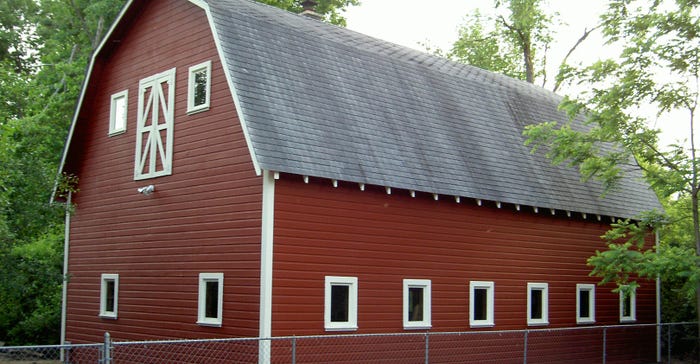March 23, 2020

When we search for a place to put down roots, we have certain needs, but we also have hopes. Not everyone, however, has a list that includes a house, 2 acres, a creek, a swimming pool and a barn.
But that is precisely what Joe and Judy Derek had in 1987, just as southeast Michigan was undergoing rapid change.
Two weeks after giving a real estate agent this challenging list, they got the call. “You won’t believe it,” the agent said. A 1.9-acre parcel on 10 Mile Road near Middlebelt in Farmington Hills, Mich., had it all — a house, a creek, a swimming pool, and best of all, a barn.
Why a barn?
“We appreciate history, and we wanted to be able to preserve a barn,” Joe says. “But we didn’t actually think we were going to get one.”
Judy adds, “When we learned the property had a barn, we said, ‘Sold!’”
Joe talks first and foremost about the barn (visible from Omenwood Avenue). “It was 30 feet by 60 feet, had a gambrel roof, and the paint was peeling. It had no barn doors, but doors like a house.”
One day, he spotted a woman videotaping from the road and learned that her connection to the barn was very special.
“I once lived in that barn,” she said, happy to find it still standing. The dimensional-lumber barn, she told him, had been built between 1935 and 1945 by her parents, the Lambert Sellers, who intended it to house ponies for her and her two siblings. A house was to be built next, but World War II broke out. Construction supplies were needed for the war effort.
The Sellers installed a wood, schoolhouse-type floor, and a chimney to vent a propane stove, and moved into the barn.
“The walls were 1-by-6 lumber, and three walls were painted,” Joe explains. Pegs driven into one wall served as a means for the children to climb to the loft, which became their bedroom. Sheets of visqueen, hung from the loft floor, created rooms and reduced drafts. A bridge was built over the creek where Mrs. Sellers washed clothes. To the east was a fruit orchard, and to the west was a farm.
The Sellers family was able to build their house in 1946, but to the Dereks’ knowledge, the barn was never used for animals.
After the Sellers left the area in 1964, the Berinni family owned the property, hosting various corporate, political and entertainment dignitaries in the barn, affectionately called The Bunkhouse.
“We had members of the Berinni family stop by one day,” Joe says. “They thought the barn would have been long gone and were happy to see it is still here.”
In the late 1990s, the Dereks undertook major work to preserve their barn.
“We discovered that development in the area had caused water to build up under our barn,” Joe explains. "Freezing water was cracking the cinder block foundation.”
The barn was raised, a French drainage system was installed, and a new foundation was built. They also replaced windows to replicate the originals and painted the barn a rich red with white trim.
But the Derek barn’s interesting history doesn’t end there. Joe and Judy discovered bits of brightly colored paper torn by a raccoon. Curious, Joe began to trace the source.
“We found that dozens of old advertising posters had been tucked into the barn’s walls for insulation by the Sellers family,” Joe explains. Over the years, the posters, sometimes four layers thick, have been carefully removed.
The Dereks have early 1900s posters from the greater Detroit area for the most part that advertise Mail Pouch Tobacco, Federal Department Stores, The Northwood Inn, Michigan State Fair, Walled Lake Amusement Park, the E & B Beer Co., Doublemint Gum, and Michigan Carnival — as well as schedules for sailing the Great Lakes on the S.S. Georgian, attending revivals or riding streetcars. A favorite advertises Shep Fields, famous in the 1930s for his “Rippling Rhythm Orchestra.”
Also on the property is an area where a chicken coop once stood and another where the Sellers family had an outhouse. “We know that outhouses can be the most interesting areas to do digs,” Joe laughs. He has found an array of old children’s toys around the yard.
Reflecting on the enjoyment the Dereks have gotten from their barn that was never a traditional functioning barn, Joe says, “When we first looked at this place, a strange feeling came over me. I knew I had been here before.”
It turned out that during a brief time as a worker for the Humane Society in the late 1960s, Joe had been called to remove a stray cat and kittens from the very barn he would one day own.
In 2011, the barn was designated as a state historic site, and the property is part of the historic district for Farmington Hills. It also is recognized as a National Wildlife Federation Backyard Habitat for butterflies and songbirds.
“We want this barn to live on for a very long time,” Joe says. “We want to be good stewards.”
Arnett is co-founder of the Barn Believers Community Project Fund. She can be reached at [email protected]. She writes from Battle Creek, Mich.
About the Author(s)
You May Also Like




